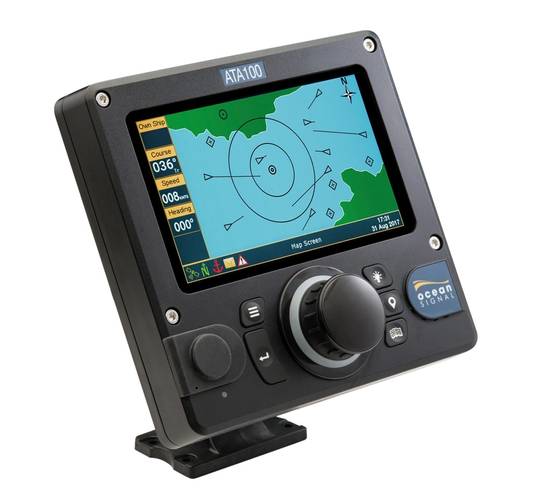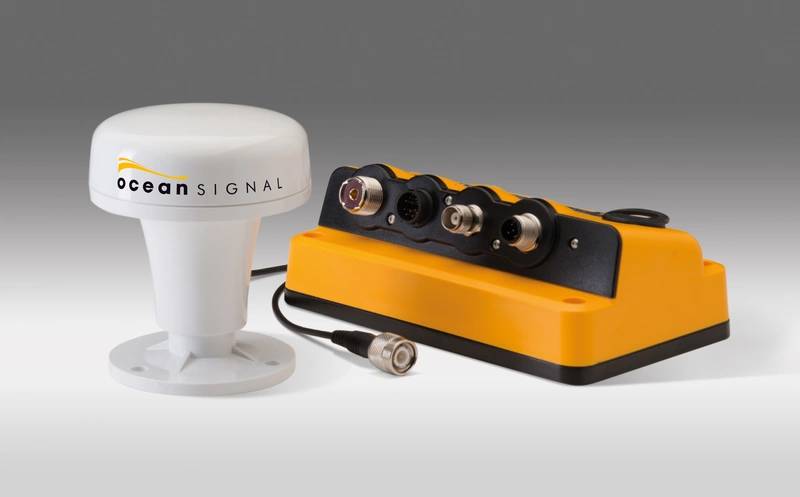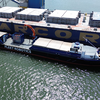Ocean Signal has rolled out its new ATA100 Class A and ATB1 Class B AIS transponders as fully compliant solutions to increase visibility, aid collision-avoidance and enhance navigational safety for a range of commercial workboats, support vessels and fishing boats. The AIS transponders were unveiled for the first time at Asia Pacific Maritime.
The ATA100 is a combined SOLAS and Inland approved single-unit device capable of exchanging dynamic and static ship data with other AIS systems and developed to meet the latest IMO carriage requirements and IEC standards.
Incorporating Ocean Signal’s trusted technology within a compact design that is easy to use and simple to install, the ATA100 is the only Class A AIS transponder available rated to the IPX7 waterproofing standard. It features a 7-inch high-intensity, full-color, rapid-response LCD to clearly display real-time marine traffic information. The coastline map and radar views have various orientation display options, whilst a standard target list display can be customized according to preference to provide immediate detailed information about nearby vessels.
The Ocean Signal Class A AIS has integrated Wi-Fi and USB interfaces for PC and tablet connection and is user-intuitive, featuring large illuminated keys and easy-to-grip jog stick. The simple-to-use AIS message-sending functionality ensures safety related messages can be quickly delivered or received by the user, while an instant message and alarm function provides immediate notification of any potential problems or hazards. Data such as location, speed over ground and course over ground is calculated automatically using the integrated 99-channel GPS receiver, while the static and voyage related data such as MMSI, call sign and identity, type of ship, destination and ETA is effortlessly programmed into the AIS transponder via a user-friendly intuitive menu interface.
Occupying a minimal amount of bridge space, the ATA100 is supplied with pilot plug and is suitable for either flush panel or free-standing mounting for easy installation into almost any position or location.
For commercial operators requiring a Class B AIS device, the Ocean Signal ATB1 is a powerful transponder incorporating superior SOTDMA technology and 5W output power. The unit uses the SOTDMA (Self Organized Time Division Multiple Access) scheme - complex AIS technology that ensures increased priority for position reports with no loss or delay of transmission - to offer captains a high strength, yet affordable, Class B device for aiding collision avoidance and providing peace of mind in areas of high traffic or poor conditions.
The Ocean Signal ATB1 has a faster reporting rate and higher output power than standard CSTDMA (Carrier Sense TDMA) Class B units, sending AIS transmissions every five seconds instead of the CSTDMA two transmissions per minute. The unit’s 5W output power, compared to the standard 2W, allows the transmissions to reach further.
With 99 acquisition channels and 33 tracking channels, the powerful internal multi-GPS receiver continuously updates vessel information, including position, speed, course and heading, for accurate global positioning. Other vessel information such as identity, call sign, type and dimensions, and MMSI is uploaded to the ATB1 via WiFi directly from Ocean Signal’s user-friendly mobile app or website to be stored for automatic transmission. The ATB1 also receives and interprets AIS messages from other AIS-equipped vessels within range, which can then be relayed to other navigation devices such as chart plotters, laptops or mobiles using the ATB1’s NMEA 0183, NMEA 2000, USB or Wi-Fi outputs.
Easy to use with accessible connections, the ATB1 features a sleek, yet rugged, waterproof design that is high on performance and low on energy consumption. It is quick and simple to install and is supplied complete with an external mount GPS antenna, ready to upload vessel information using a mobile phone, tablet or PC.
Both the Class A and Class B units are compatible with Ocean Signal’s rescueME MOB1 man overboard AIS/DSC device, providing immediate notification in the event that a MOB1 should be activated. The ATA100 is programmable to accommodate up to 30 MOB units.
















